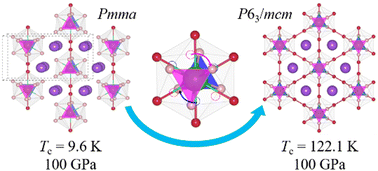Emergent superconductivity in K2ReH9 under pressure†
Abstract
Pressure, as a controllable thermodynamic parameter, can substantially modulate the structural topologies, e.g., phase transition, and electronic properties of the known compounds. Herein, we found that the compression of H-rich compounds, stabilizing at ambient conditions, is an applicable route to achieve high-temperature superconductivity at a lower pressure (<100 GPa). First-principles calculations reveal that under compression, K2ReH9 experiences structural transforms from P![[6 with combining macron]](https://www.rsc.org/images/entities/char_0036_0304.gif) 2m symmetry to Pmma phase via an intermediate Pma2 phase, then to P63/mcm phase, accompanied by semiconductor-to-metal transition. More interestingly, the estimated superconducting transition temperature (Tc) of P63/mcm phase is up to 127.1 K at 75 GPa, comparable to the well-known LaBH8, a low-pressure dynamically stable superconductor. Additionally, from Pmma to P63/mcm phase, the enhanced number of H–H covalent bonds and their weakened strength, caused by the rotation of H triangles in ReH12 icosahedra, are responsible for the remarkable elevation of Tc value.
2m symmetry to Pmma phase via an intermediate Pma2 phase, then to P63/mcm phase, accompanied by semiconductor-to-metal transition. More interestingly, the estimated superconducting transition temperature (Tc) of P63/mcm phase is up to 127.1 K at 75 GPa, comparable to the well-known LaBH8, a low-pressure dynamically stable superconductor. Additionally, from Pmma to P63/mcm phase, the enhanced number of H–H covalent bonds and their weakened strength, caused by the rotation of H triangles in ReH12 icosahedra, are responsible for the remarkable elevation of Tc value.



 Please wait while we load your content...
Please wait while we load your content...